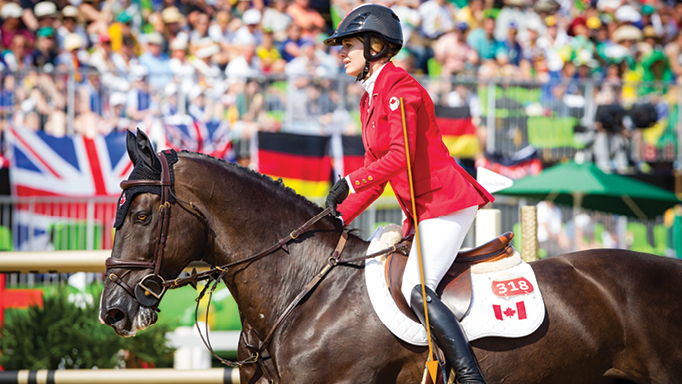In my mind, a correct two-point position means your legs are stretching down in even contact around your horse with your heels down. The only ‘two points’ in contact with the saddle should be your two legs, as your seat is elevated, and when in the correct balance there should be an invisible line connecting your shoulder, knee, and toe. Hands should be carried slightly off the neck and supported out in front of you.
Working in the two-point is great conditioning for a rider when it’s practiced on the flat. It helps stretch your heels down and helps strengthen your leg muscles. The two-point is essentially your jumping position; when you leave the ground and are airborne, you are almost always in a two-point contact following the horse (unless something has gone horribly wrong!).
The use of the two-point varies with riding style in between the obstacles. The typical North American style of riding is more forward and the riders are in a version of two-point at all times (see Katie Prudent), whereas the typical German style of riding uses a full seat (see Christian Ahlmann). Having said that, our sport is so global that I think it’s more rider preference and horse-specific nowadays. The horse I ride in the lightest position is Brighton; he is sensitive and likes a forward ride to encourage him across the oxers.
Practising in a two-point position is more beneficial for the rider in terms of conditioning, but it can also be beneficial for a horse that has a tight back to start the ride in a two-point position. An entire lesson in two-point would be almost impossible, but I think integrating it into lessons as interval training is an excellent exercise to develop that strength and comfort in what is an essentially a basic position.
The most common error I see in a two-point position is when riders balance with their hands on the horse’s neck or, worse, on the horse’s mouth. The whole purpose of the two-point is to work on your own balance and give your horse some freedom. I think anyone struggling with the two-point position probably just needs to practice and strengthen the muscles that are used in this position. The best off-horse exercise to strengthen those muscles would probably be squat reps. On-horse, the best gait for strengthening the position is likely the trot, which is something that can be introduced early on in a rider’s education.

